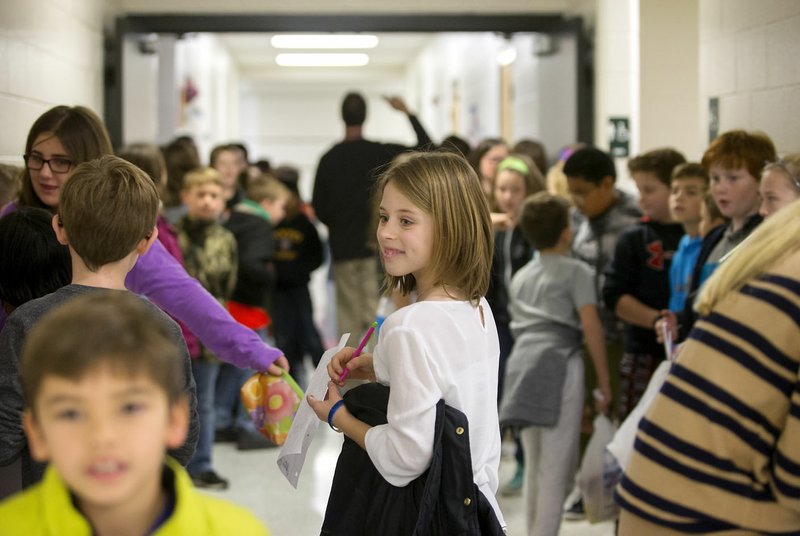BENTONVILLE -- School District officials don't intend to change attendance zone boundaries for the 2017-18 school year, despite projections showing a few elementary schools will be near or above capacity.
Tanya Sharp, executive director of student services, presented enrollment projections for each building at Monday's board meeting.
Projections
Here are enrollment projections for each of Bentonville’s 11 elementary schools for the 2017-18 school year, assuming current students all roll up a grade level and kindergarten capacity is met. The projections do not try to forecast additional enrollment growth.
School2017-18 EnrollmentPercent of capacity
Apple Glen62298 percent
Centerton Gamble64388 percent
Central Park81596 percent
Cooper66888 percent
Elm Tree657103 percent
Mary Mae Jones62699 percent
Osage Creek56778 percent
R.E. Baker54085 percent
Sugar Creek48276 percent
Thomas Jefferson56793 percent
Willowbrook72485 percent
Source: Bentonville School District
The projections didn't forecast enrollment growth. Sharp's presentation showed what enrollment would look like by advancing students one grade level, subtracting the senior class and assuming capacity at the kindergarten level will be met -- a total of 1,460 students.
Elm Tree Elementary School is projected to be over capacity by about 20 students when the school year begins. Other areas of concern include Central Park Elementary School, which is projected to be at 96 percent of capacity, and Mary Mae Jones Elementary School, projected to be at 99 percent.
Sugar Creek Elementary School, meanwhile, is projected to be at 76 percent, the lowest of the 11 elementary schools. Sugar Creek draws some of its students from the downtown area, and "younger families are moving out of that area," Sharp said.
The district considered tweaking attendance zones for next school year, but opted to wait, Sharp said.
"Knowing we're going to have an elementary school opening in 2019, we feel like our recommendation should be to wait. We want to move kids as few times as possible," she said.
The district will come back to the board with a recommendation to rezone for the 2018-19 school year that would include a zone for the 12th elementary school, which is part of a larger facility plan that depends on voters' approval this year of a 1.9-mill tax increase.
Setting new zones a year in advance of a school opening is similar to what the board did last year, when it included zones for Osage Creek Elementary School and Creekside Middle School as part of a rezoning plan. Both of those schools are expected to open this fall. Elementary students zoned for Osage Creek and middle students zoned for Creekside are now spread out among other district schools.
Travis Riggs, board president, said he's glad the district isn't changing attendance zones for next school year, because rezoning is "painful" for everyone. At the same time, he said, that means some schools will bear more stress than others in the short term.
"So parents need to understand, no rezoning comes at some cost, some price," Riggs said. "You know, it's not always easy."
The five middle schools and two high schools are all expected to be well below capacity next school year. At the junior high level, the biggest concern is at Fulbright Junior High School, which will be at 90 percent of its 1,000-student capacity.
The district considers a school's capacity to be the maximum number of students the school can enroll while using all of its space as it was designed to be used. Schools can go above capacity by getting creative with the use of its space.
Willowbrook Elementary School, for example, had an enrollment of 936 as of last month. Its capacity is 853, according to a district document. Willowbrook is holding 265 of those students zoned for Osage Creek, so its enrollment is projected to drop below capacity next school year.
A total of 128 students at the elementary level are being "overflowed" from the school for which they're zoned to another school. The overflow is because of new families that have moved into the district since last summer and those who chose to move into a different zone, Sharp said.
More than 700 students were impacted by overflow last year. The School Board adopted new attendance zones at the elementary and middle levels for this school year that reduced overflow.
Willie Cowgur, board vice president, asked Sharp what the overflow number will be next school year. Sharp said it should go down "significantly" with the opening of Osage Creek Elementary and Creekside Middle schools.
The district's enrollment grew about 3.4 percent this school year over last school year. Officials tentatively are expecting growth of 3.5 percent next school year, which would increase enrollment to more than 17,000.
NW News on 01/13/2017


